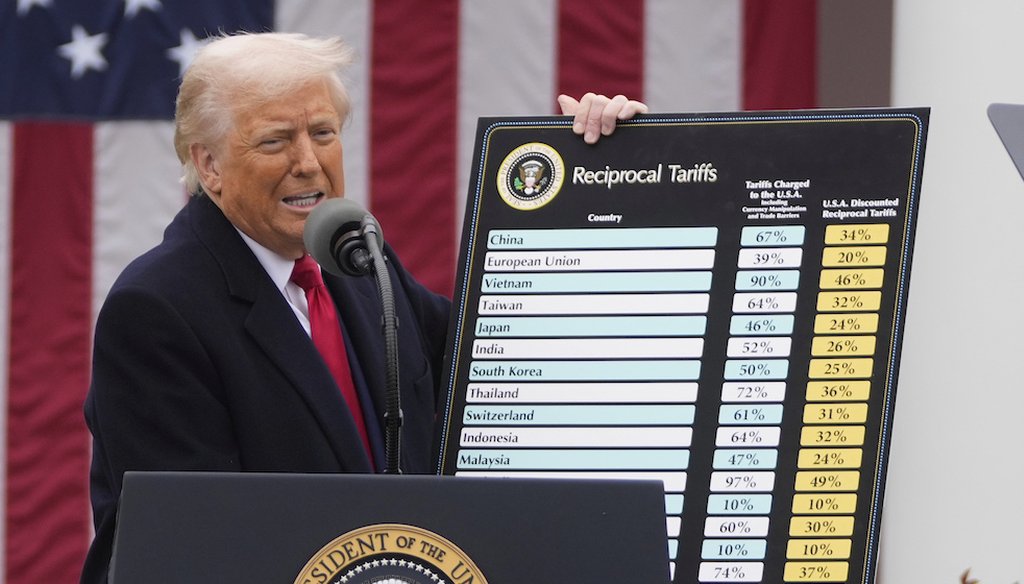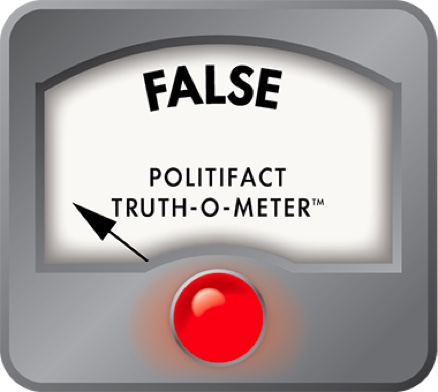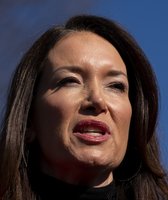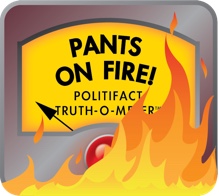Stand up for the facts!
Our only agenda is to publish the truth so you can be an informed participant in democracy.
We need your help.
I would like to contribute

President Donald Trump speaks during an event to announce new tariffs in the Rose Garden at the White House, April 2, 2025, in Washington. (AP)
If Your Time is short
-
Tariffs are a tax on imported goods that businesses pay. Their cost is often passed down to consumers through higher prices. Economists say it’s fair to call tariffs a tax.
-
Economists’ estimates vary, but the new average effective tariff rate as of April 7 is higher than it has been in almost a century.
-
When measuring how much revenue the U.S. expects to collect, economists rank Trump’s "tax hike" higher than any tax policy since 1982, and many estimates show it could be the largest increase since 1951.
Politicians and economists said President Donald Trump’s "Liberation Day" tariff rollout amounted to a historic tax increase.
"Donald Trump just imposed the largest tax hike in our lifetime," Democratic California Gov. Gavin Newsom posted April 2 on X.
Other Democratic politicians made similar claims, including Illinois Gov. JB Priztker, U.S. Sen. Chuck Schumer, D-N.Y. and U.S. Rep. Jared Moskowitz, D-Fla. Republican Mike Pence called it "the largest peacetime tax hike in U.S. history."
It’s clear the change under the April 2 plan is historic. The global tariffs Trump announced target almost every country in the world. All countries on the list face a baseline tariff of 10%, with others facing tariffs as high as 50%.
Estimates vary for the tariff hike’s scope, partly because of Trump’s back and forth on specific tariffs, and global market unpredictability. Trump has repeatedly posted on social media that he is negotiating with countries over their tariff rates, so plans could shift.
Measuring by how much the average tariff rate has increased, Trump’s tariff hike ranks as the biggest in almost a century. Measuring by how much tax revenue the tariffs will bring in, estimates vary.
Sign up for PolitiFact texts
Five out of the seven estimates PolitiFact identified rank these new tariffs as the biggest tax increase since 1951, with the most conservative estimate ranking it as the largest since 1982.
Is increasing tariffs the same as a 'tax hike'?
Experts say it is fair to call tariffs a tax.
"They are taxes that apply to U.S. imports," said Erica York, vice president of federal tax policy with the Tax Foundation, a nonpartisan think tank.
Tariffs are import taxes businesses pay to the federal government when purchasing goods and materials from other countries. Businesses often pass along that increased cost to U.S. consumers.
Reports from economic policy think tanks with a wide range of political views describe tariffs as a regressive tax, meaning lower income groups are hit harder by the rising costs.
RELATED: Karoline Leavitt says tariffs are ‘a tax cut.’ Economists say they aren’t
Economists say this tariff rate hike hasn’t been seen in almost a century
Measuring tariff hikes comes with challenges. The tariff rates vary by country and include carve-outs for specific goods.
Trump’s tariff policy has been volatile, with tariffs announced and then rapidly pulled back, sometimes within the day. They could change depending on how countries negotiate with the U.S. or respond with their own tariffs.
One way to measure this tariff hike’s size is to compare the new average effective tariff rate with historic rates.
Various economic policy groups including the Tax Foundation, the Yale Budget Lab and JP Morgan Chase estimated the new tariff rate at 16.5%, 22.5% and 27%, respectively. Each rate is the largest in nearly a century.
When Trump took office, the average effective tariff rate was 2.4%.
When measuring new tariffs by expected revenue, it’s still historic
Another way to measure tariffs’ impact is by expected revenue collections. The more revenue the government collects, the bigger the hike.
The Trump administration has argued that by raising revenue through tariffs, other federal taxes could be cut. Economists previously told us it’s unlikely high tariffs could generate enough revenue to result in meaningful tax reductions for typical Americans.
Some of the largest estimates of tariff tax revenue have come from the Trump administration. In a March 30 Fox News interview, White House trade adviser Peter Navarro said that nonauto tariffs "are going to raise about $600 billion (a year), about $6 trillion over a 10-year period," with an additional $100 billion a year from auto tariffs.
One way economists put these estimates in historical context is by examining increases in tax revenue as a percentage of gross domestic product.
A 2006 Treasury Department report calculated this value for all major tax bills since 1940.
Most of the largest tax increases took place during wartime, in the 1940s and 1950s.
If tax revenue increased by the amount Navarro estimated, $700 billion, it would represent about 2.3% of America’s almost $30 trillion GDP, making it the largest tax increase since 1942.
Navarro didn’t detail how he arrived at that $700 billion figure, but CNN found it would require a 20-25% tariff on $3.3 trillion worth of goods, which is how much the U.S. imported in 2024.
Some economists questioned Navarro’s estimate. "Plainly put, the Navarro estimate is flat out wrong," York told PolitiFact. "Tariffs will reduce imports, and they will mechanically reduce income and payroll tax revenues; if you don’t account for those you significantly oversell how much revenue tariffs will yield."
The U.S. economy could shrink, imports could drop and other countries could retaliate with their own tariffs, all resulting in lower tax revenue from tariffs.
The Tax Foundation’s revenue estimate for 2025 was lower at $258.4 billion, or 0.85% of GDP, which would make it the largest tax increase since 1982.
Michael Feroli, chief economist at JPMorgan Chase, offered an estimate of $400 billion, or about 1.3% of GDP. Feroli described this as the largest tax increase since 1968, but based on data from the Treasury Department, 1.3% of GDP would make it the highest since 1951.
Dean Baker, co-founder of the Center for Economic and Policy Research, a liberal think tank, told PolitiFact some revenue estimates looked too low. He estimated nearly $1 trillion in tax revenue.
"As a practical matter, some goods are exempted and demand will surely fall, so it won't be anywhere near that high, but I think even the JP Morgan number is very low," said Baker.
Five out of seven of the estimates that we identified for Trump’s tariff plan are the highest since 1951.
Our Sources
Email Interview with Garrett Watson, Director of Policy Analysis at the Tax Foundation, April 3-4, 2025
Email Interview with Brandon Richards, Deputy Director for Rapid Response in the Office of Governor Gavin Newsom, April 3, 2025
Email Interview with John Buhl, Communications Director at Urban Institute & Brookings Tax Policy Center, April 3, 2025
Email Interview with Erica York, Vice President of Federal Tax Policy at the Tax Foundation, April 3, 2025
Email Interview with Dean Baker, co-founder of the Center for Economic and Policy Research, April 3-4, 2025
Email Interview with Kent Jones, professor of international economics at Babson College, April 3-4, 2025
The New York Times, "Trump Tariffs Chart: See Which Countries Have the Highest Rates - The New York Times," April 2, 2025
Reuters, "Tiny Australian outposts, including some with no people, targeted by Trump tariffs | Reuters," April 4, 2025
Gavin Newsom, "X post," April 2, 2025
Mike Pence, "X post," April 2, 2025
JB Pritzker, "X post," April 3, 2025
Chuck Schumer, "X post," April 3, 2025
Jared Moskowitz, "X post," April 2, 2025
PolitiFact, "Would Donald Trump’s proposed tariffs hit typical families by $4,000, as Kamala Harris said?," Aug. 30, 2024
PolitiFact, "Economists say JD Vance is wrong about benefits of tariffs outweighing negatives," Aug. 29, 2024
PolitiFact, "Karoline Leavitt says tariffs are ‘a tax cut.’ Economists say they aren’t," March 13, 2025
The Washington Post, "The false things Trump said about tariffs during his announcement," April 3, 2024
The Yale Budget Lab, "Where We Stand: The Fiscal, Economic, and Distributional Effects of All U.S. Tariffs Enacted in 2025 Through April 2," April 2, 2025
Peterson Institute for International Economics, "Can Trump replace income taxes with tariffs?," June 20, 2024
Economic Policy Institute, "Tariffs—Everything you need to know but were afraid to ask," Feb,. 10, 2025
Center for Economic Policy Research, "US tariffs are an arbitrary and regressive tax," Jan. 12, 2017
The Tax Foundation, "Tariffs Definition | TaxEDU Glossary," Dec. 7, 2022
The Heritage Foundation, "How Tariffs and Regressive Trade Policies Hurt the Poor," Dec. 15, 2017
PolitiFact, "Karoline Leavitt says tariffs are ‘a tax cut.’ Economists say they aren’t," March 13, 2025
The New York Times, "Trump Tariffs Chart: See Which Countries Have the Highest Rates," April 2, 2025
The New York Times, "A Timeline of Trump’s Tariff Fight With Canada, Mexico, China and the E.U."
NPR, "Timeline of Trump's tariff threats, deadlines and pauses," April 2, 2025
CNN, "China imposes 34% reciprocal tariffs on imports of US goods in retaliation for Trump’s trade war," April 4, 2025
CNBC, "Trump open to tariff negotiations, contradicting White House aides," April 4, 2025
Britannica, "international trade: Measuring the effects of tariffs," accessed April 4, 2025
Statista, "U.S. Tariffs Forecast To Hit Highest Levels Since 1910 Under Trump," April 3, 2025
Fitch Rating, "‘Liberation Day’ Takes US Tariff Rate Back to Level Last Seen in 1909," April 3, 2025
Tax Foundation, "Trump Tariffs: The Economic Impact of the Trump Trade War," April 4, 2025
The Yale Budget Lab, "Where We Stand: The Fiscal, Economic, and Distributional Effects of All U.S. Tariffs Enacted in 2025 Through April 2," April 2, 2025
JP Morgan Chase, "Tariff update and what they mean for markets," April 3, 2025
PolitiFact, "Karoline Leavitt says tariffs are ‘a tax cut.’ Economists say they aren’t," March 13, 2025
Fox News, "Peter Navarro says the ‘bigger picture’ is ‘restoring’ the American manufacturing base," March 30, 2025
https://home.treasury.gov/system/files/131/WP-81.pdf
The Wall Street Journal, "Here’s One Estimate for How Much Revenue the U.S. Government Will Raise With Trump’s Tariffs," April 3, 2025
CNN, "Trump side says tariffs will raise $6 trillion, which would be largest tax hike in US history," March 31, 2025
Tax Foundation, "Placing Harris and Trump Tax Plans in Historical Context," Oct. 24, 2024
White House, "https://www.whitehouse.gov/wp-content/uploads/2025/04/Annex-III.pdf
The Washington, "Opinion | Trump’s tariffs exploit powers that Congress unwisely ceded long ago," April 3, 2025
Yahoo Finance, "We now know the full extent of Trump's reciprocal tariffs. They’re huge.," April 2, 2025
The Wall Street Journal, "A $6 Trillion Trump Tax Increase?," March 31, 2025
CBS News, "Trump says his tariffs could bring in trillions in revenue. Economists disagree," April 2, 2025
Forbes, "Trump's Tariffs: Biggest Tax Hike Since 1982," April 4, 2025
The Tax Foundation, "The Truth About Tariffs—Fact-Checking Trump’s Trade Claims," April 4, 2025
FactCheck.Org, "Trump's Misleading Tariff Chart," April 3, 2025
CNBC, "U.S. tariff rates under Trump will be higher than the Smoot-Hawley levels from Great Depression era," April 3, 2025
Federal Reserve Bank of St. Louis, "Gross Domestic Product (GDP)," accessed April 7, 2025
International Trade Administration, "Import Tariffs & Fees Overview and Resources," accessed April 7, 2025
Investopedia, "How Massive Are Trump's Tariffs? Here Are 3 Graphs That Explain," April 4, 2025
CNBC, "U.S. tariff rates under Trump will be higher than the Smoot-Hawley levels from Great Depression era," April 3, 2025
The Associated Press, "Here's what tariffs are and how they work," March 4, 2025






















